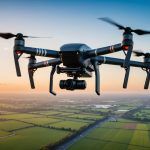Understanding the UK Drone Industry
The UK drone industry has been witnessing impressive growth, with significant implications for the broader aviation market. Fuelled by advancements in technology, drones have moved beyond mere recreational devices to critical components in various sectors such as agriculture, logistics, and public safety. This robust expansion necessitates a comprehensive understanding of drone regulations which govern their use and promote safety across the skies.
The current landscape of drone regulations in the UK is shaped by the necessity to ensure safe operations. Governing bodies enforce strict guidelines on drone flights near restricted zones, maintaining a balance between innovation and public safety. Key regulations include registration requirements for drones weighing over 250 grams and adherence to operating height restrictions to ensure collision avoidance.
In parallel : Key actions for ensuring fire safety compliance in your new uk manufacturing plant
In the realm of drone maintenance, key players are emerging as leaders in the fast-evolving market. They focus on innovative solutions to enhance drone durability and performance. Market trends indicate a rise in demand for maintenance services which support sustained drone operations. By integrating cutting-edge technologies and intuitive solutions, the industry seeks to maintain the equilibrium between the rapid evolution of drone capabilities and compliance with aviation safety standards.
Legal Requirements for Starting a Drone Maintenance Business
Establishing a drone maintenance business in the UK necessitates understanding specific legal requirements to ensure smooth operations. Business registration is a fundamental step, aligning with typical entrepreneurial mandates. This involves registering your company with Companies House and selecting appropriate business structures such as sole proprietorship or limited company status.
Also to see : Kickstart your dream artisanal chocolate venture in the uk: essential insights for food safety compliance
Drone operations also demand compliance with drone licenses. To legally conduct maintenance work, business owners and technicians may need operational authorisations from the Civil Aviation Authority (CAA). Adhering to these guidelines safeguards against potential legal repercussions.
Apart from registration and licensing, insurance and liability considerations are crucial. Insurance protects against unforeseen accidents and incidents that may arise during drone operations. A robust policy tailored to cover equipment and potential third-party liabilities ensures comprehensive protection.
Ensuring the legal framework is well-established not only fortifies your establishment but also instils confidence among potential clientele. By meeting these essential legal prerequisites, you lay the groundwork for a successful drone maintenance enterprise equipped to navigate the UK’s booming drone industry landscape.
Aviation Safety Compliance and Regulations
In the UK, aviation safety compliance is pivotal for the thriving drone sector. The Civil Aviation Authority (CAA) plays a crucial role by enforcing regulations to enhance airspace safety. These regulations establish guidelines for drone operations, ensuring they meet stringent safety standards and offering structured oversight within the industry.
Adhering to CAA regulations requires businesses to develop comprehensive safety compliance checklists. These checklists help in systematically examining drone components, assessing operational risks, and ensuring repairs and maintenance activities meet prescribed standards. Regular updates to these checklists ensure alignment with evolving regulations and technological advancements.
Continuous monitoring is an essential facet of maintaining compliance. It includes regular training for technicians, auditing drone usage, and ensuring documentation of each maintenance task. Similarly, adherence to safety standards is ongoing, necessitating relentless diligence to avoid any lapses that might compromise drone performance or safety.
Ultimately, profound knowledge of regulations alongside rigorous safety protocols empowers businesses to operate effectively and maintain customer trust. As safety compliance underpins operational legitimacy, businesses must stay vigilant and informed about new regulatory changes to navigate the UK’s dynamic drone landscape confidently.
Best Practices for Drone Maintenance
In the evolving landscape of drone maintenance practices, having structured maintenance checklists is essential for ensuring optimal performance and longevity of drones. These checklists should be tailored to various drone models, covering all critical components. This approach aids in identifying potential issues early, mitigating risks associated with drone failures.
Addressing common technical issues is a key element in maintenance. Problems such as battery drainage, propeller wear, and software glitches are frequent. Solutions involve regular inspections, timely replacements of worn components, and software updates. Employing a proactive maintenance strategy is vital for reducing unexpected downtimes.
Regular inspections are indispensable. They involve comprehensive evaluations of both hardware and software systems. Additionally, meticulous record-keeping is an integral practice, facilitating audits and ensuring compliance with technical standards. Documenting maintenance activities not only helps track drone health but also aids in identifying patterns over time, contributing to more informed decision-making.
Adopting these best practices enhances the reliability and efficiency of drone operations. By setting robust maintenance protocols, businesses can ensure their drones consistently perform at peak ability, meeting the high technical standards demanded in this dynamic industry.
Certifications and Training for Technicians
Navigating the world of drone technician certifications is essential for ensuring top-notch expertise in the maintenance field. Recognized certification programs, such as those provided by the Association for Uncrewed Vehicle Systems International (AUVSI), arm technicians with the necessary skills to keep up with the rapidly evolving drone industry. These programmes cover a range of areas from basic repairs to advanced diagnostics, tailored to support career progression.
Ongoing training programs are crucial not just for skill acquisition but for consistent skill enhancement. By staying updated on the latest drone regulations and technologies, technicians can effectively address complex maintenance challenges. This commitment to learning bolsters operational efficiency by ensuring drones remain in peak condition.
Forging partnerships with established training organizations allows businesses to integrate best practices into their operations. Such alliances facilitate continuous professional development, equipping technicians with actionable insights and hands-on experience in advanced maintenance techniques. Ultimately, by investing in education and certification, businesses guarantee that their teams are both competent and competitive in the growing aviation market. These efforts are instrumental in maintaining high-quality standards and fostering trust with clientele.
Recommended Equipment for a Drone Maintenance Venture
Effective drone maintenance requires the right maintenance equipment and tools to ensure optimal drone performance. For precision repairs and diagnostics, investing in a range of high-quality tools and equipment is essential. Multimeters and digital testers are fundamental for diagnosing electrical issues, while soldering kits are indispensable for circuit board repairs.
Moreover, having specialised cleaning kits ensures components remain in prime condition, preventing debris-related malfunctions. It’s important to select brands known for reliability and durability to handle the rigorous demands of drone operations. Brands such as Fluke for multimeters and Hakko for soldering kits are highly regarded in the field for their precision and reliability.
Staying updated with innovations in drone maintenance technology can give a competitive edge. For instance, using drones equipped with diagnostic software can expedite the maintenance process. These advancements allow for real-time problem identification and resolution, enhancing operational efficiency.
In this dynamic market, investing in the right equipment is crucial for sustaining high service standards and building trust with customers. By focusing on quality and technological advancements, businesses can ensure they are well-equipped to handle current and future drone maintenance challenges.
Strategies for Successful Business Management
Navigating successful business management involves implementing efficient strategies that foster growth and sustainability. Integral to this process are robust marketing strategies, which should be tailored to the unique demands of the drone maintenance market. Emphasising digital marketing, establishing a strong online presence, and engaging with targeted audiences can significantly enhance brand visibility and customer reach.
Operational efficiency is another cornerstone of a thriving business. Streamlining processes and adopting innovative technologies can reduce downtime and boost productivity. Employing project management tools ensures that resources are used effectively and that maintenance services meet high standards consistently.
Equally important is the focus on customer service and relationship management. Building trust through excellent service provision and open communication can lead to repeat business and positive referrals. Understanding customer needs and expectations fosters long-term loyalty and enhances the business’s reputation.
A business that adeptly balances marketing, operational efficiency, and customer relations is well-placed to thrive in the competitive drone maintenance industry. Implementing these strategies not only fortifies the company’s market position but also propels it toward sustained success.
Navigating Challenges in the Drone Maintenance Industry
Navigating the drone maintenance industry demands a keen understanding of potential challenges and strategic approaches to mitigate risks effectively. Businesses frequently confront issues such as fluctuating market demand, technological obsolescence, and regulatory changes. Recognising these industry challenges allows businesses to develop proactive solutions.
Risk management is crucial in addressing technological challenges. By incorporating regular updates and adopting future-proof technologies, businesses can stay ahead of the curve. Implementing contingency plans for unforeseen regulatory changes ensures operations are adaptive and compliant.
Understanding the competitive landscape is indispensable for market positioning. Entrepreneurs should analyse competitor strategies and market trends to tailor their services effectively. Maintaining a competitive edge requires continuous innovation and investment in personnel training and cutting-edge equipment.
Businesses can strengthen their market stance by selectively focusing on customer satisfaction. Enhancing service quality, timely troubleshooting, and consistent communication build long-term relationships and foster market loyalty. Emphasising these strategies equips businesses to withstand industry pressures and excel in the dynamic UK drone maintenance sector.











